Introduction
Today’s automobiles can be considered a culmination of industrial design. A car can be divided into three main systems:
- Powertrain
- Chassis
- Body
The suspension system to be introduced in this article belongs to the chassis system. The primary function of the suspension is to provide ride comfort. In other words, in the face of various road conditions, the suspension system must strive to maintain stability to achieve the goal of providing comfort. The main components of the suspension system include control arms, shock absorbers, springs, anti-roll bars, and more. With the coordinated movement of these parts, the suspension system can respond to the challenges posed by different road surfaces.
It’s important to note that the classification of the chassis and suspension is somewhat ambiguous. Each component also has many different names, depending on the car manufacturer, country, producer, modifications, literature, and various sources, leading to different definitions. Individuals in related industries often have varying perspectives. Therefore, it’s not necessary to get overly caught up in classifications and names; a basic understanding is sufficient.
History and Functions
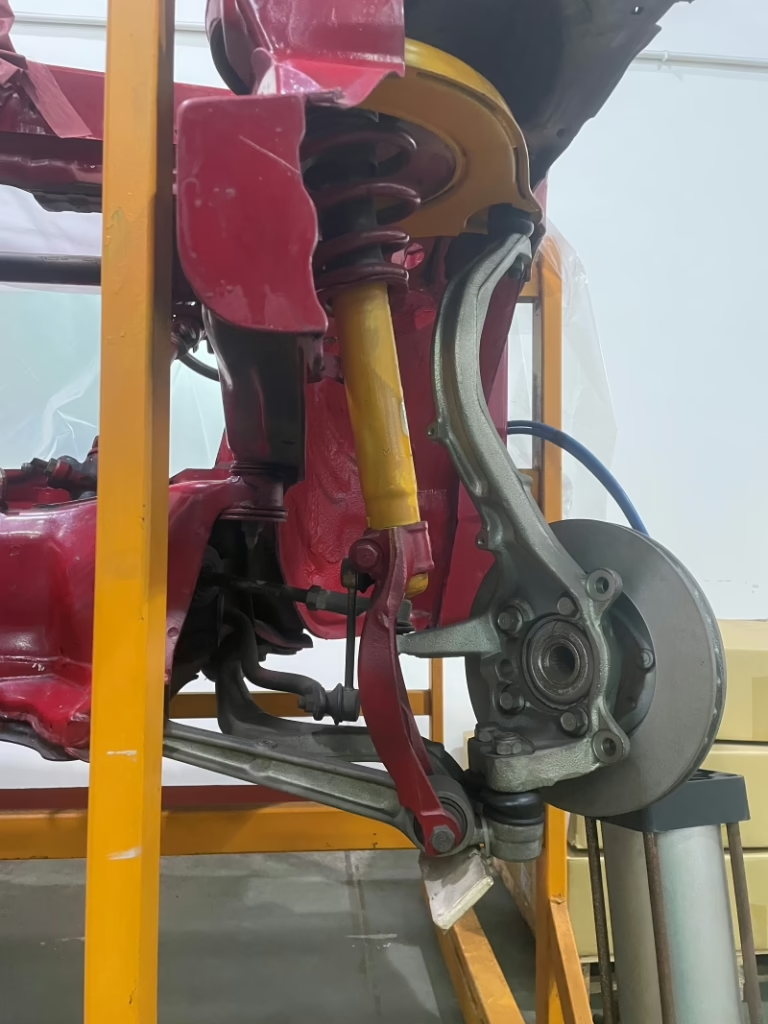
front suspension and steering system
To understand the automotive suspension system, starting from the perspective of human history can help us better grasp the function of the suspension system. The concept of automotive suspension originated in the era of horse-drawn carriages. In the early days of horse-drawn carriages, before the invention of suspension systems, the wheels were directly fixed to the carriage body through the axle. Essentially, it was a box with wheels, providing a convenient means of transportation but lacking in comfort. This design meant that all road conditions were directly transmitted to the carriage body. Whether encountering potholes, uneven terrain, or turns, every movement experienced by the wheels was conveyed unabated into the cabin.
At this point, the function of the suspension system becomes evident—by reducing vibrations transmitted from the road to the vehicle body.
- Enhance the comfort of the passenger
- Reduce wear and tear on the vehicle’s body structure
As time progresses, the understanding and development of suspension systems continue to deepen. In modern automobiles, the functions performed by suspension systems can be generally classified into the following:
Enabling Vehicle Movement, Braking, and Steering
Maintaining Road Contact During Driving
Reducing Road-Induced Vibrations for Improved Comfort
Supporting Vehicle Weight
Limiting Tire Displacement for Increased Handling Limits and Driving Safety
Facilitating Power Transmission to the Road
Components
Spring
Springs are the core components of the suspension system, and their primary function is to support the weight of the vehicle and absorb road vibrations. They can be broadly categorized into four types:
- Torsion Bar (Not torsion beam) : A slender rod-shaped component is positioned parallel to the vehicle body. It is nearly obsolete in modern vehicles, with only a few using this design.
- Leaf Spring : Composed of multiple thin, elongated steel plates stacked together and secured with shackles. The number of leaves can be adjusted by the manufacturer based on the vehicle’s load requirements. Commonly found in vehicles that need high load-carrying capacity or some off-road vehicles.
- Coil Spring : A spring with a coiled, spiral shape, similar to the commonly seen springs. Over 80% of vehicles use this type of spring, making it the most widely used in contemporary suspension systems.
- Air spring
Damper
The main function of the damper is to absorb and control the vibrations of the spring, and it is not responsible for bearing the weight of the vehicle body.
Control Arm
The control arm connects the steering and the vehicle body to control the range and direction of tire movement, allowing the vehicle to travel smoothly on the roadway. The control arm is comprised of a ball joint and a bushing, available in various shapes, depending on the designer’s desired outcome.
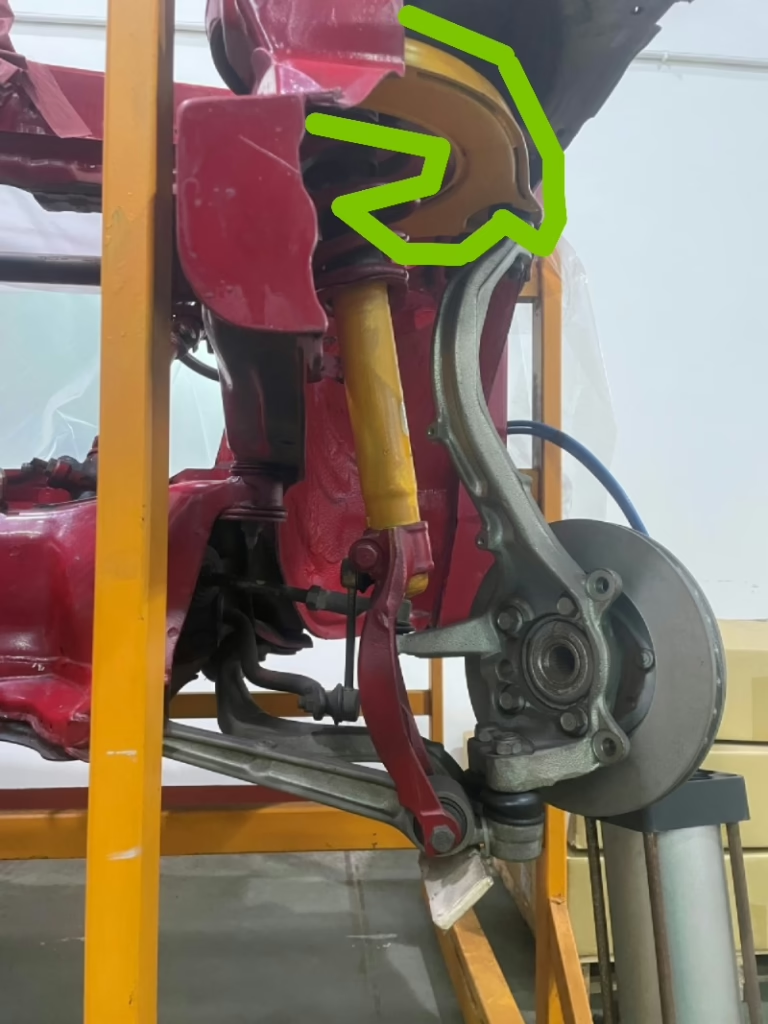
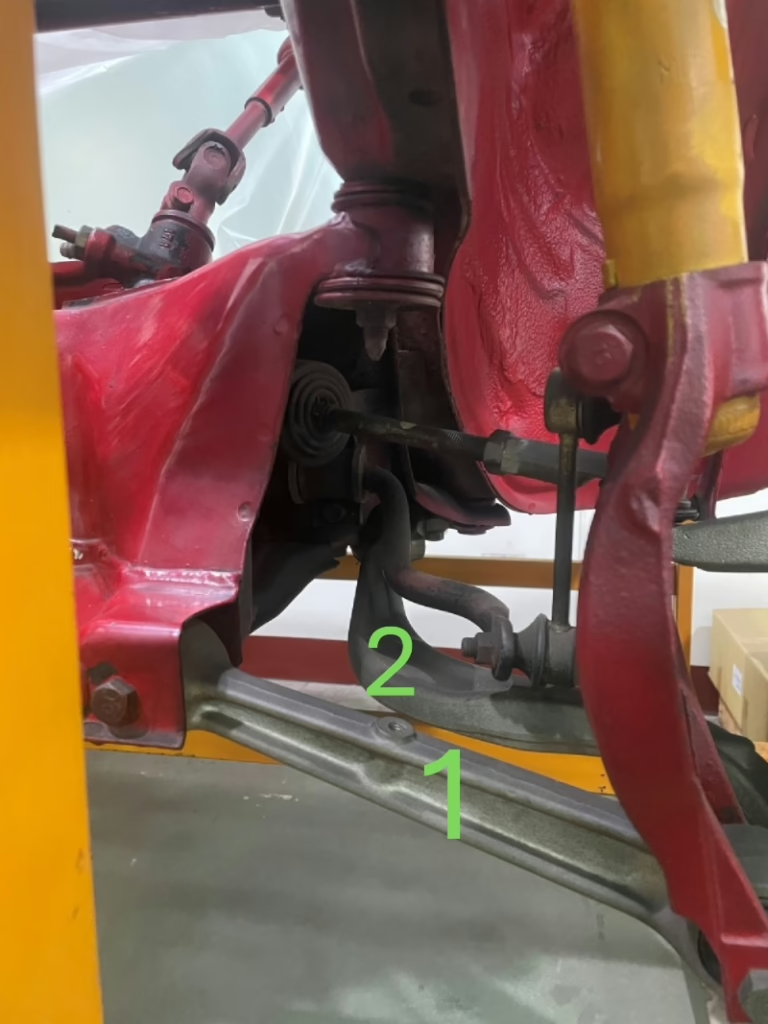
Stabilizer link
As the name suggests, this component is used to connect the anti-roll bar and usually does not come with additional functions other than the connection. One end is linked to the anti-roll bar, and the other end, based on the manufacturer’s design, may be connected to the control arm or damper. For modified cars, adjustable stabilizer link is an essential part.
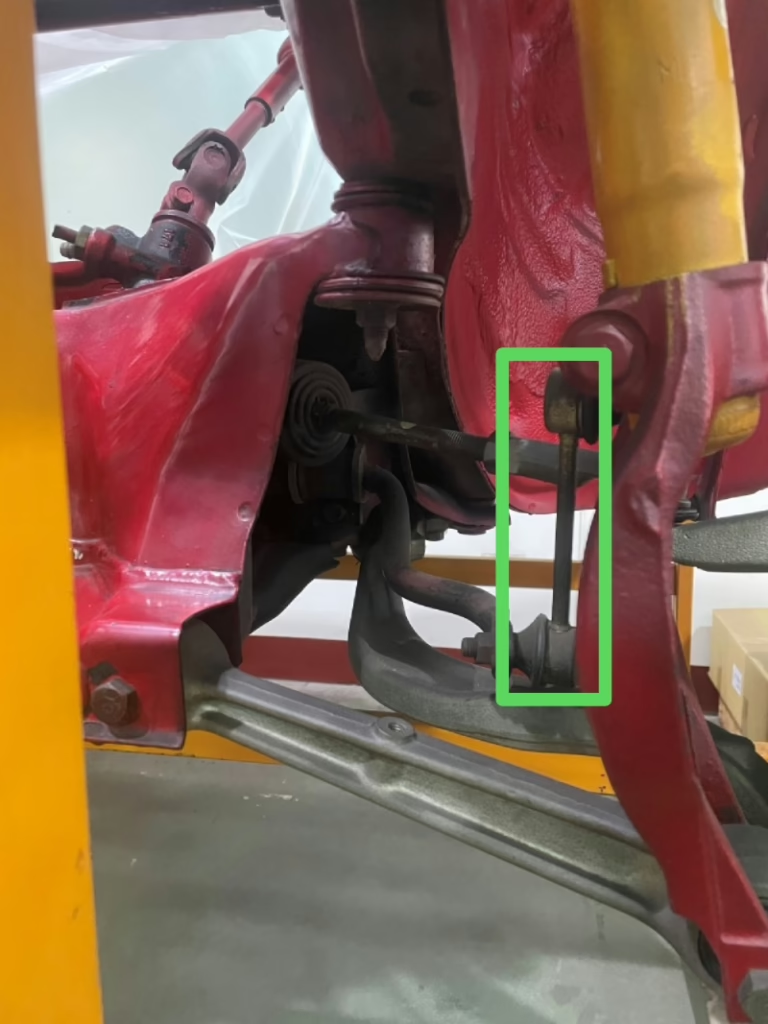
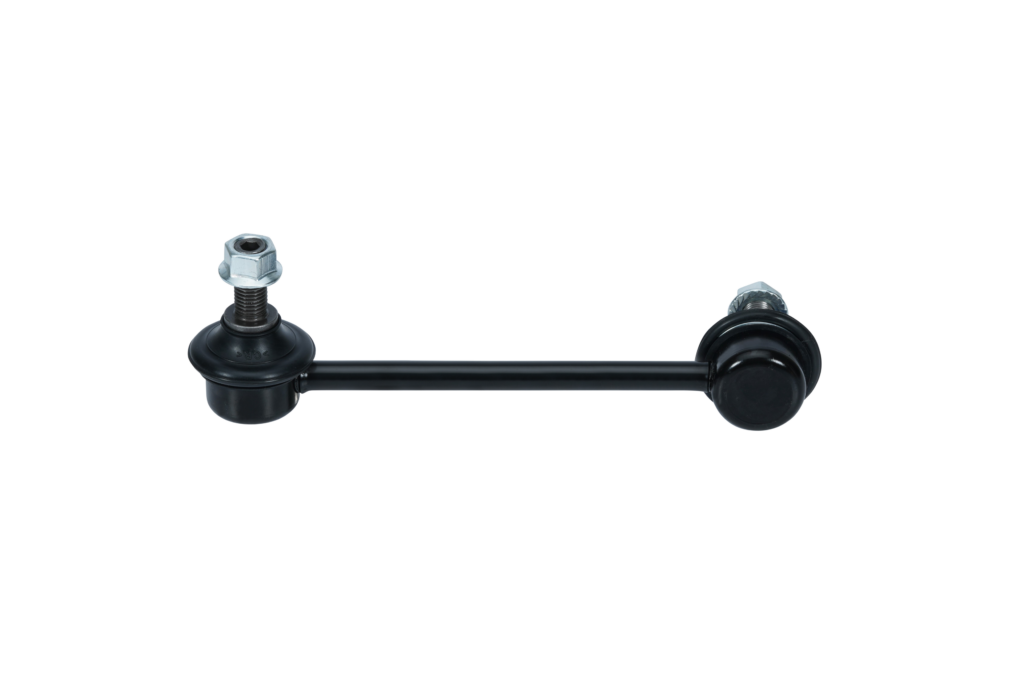
Stabilizer
The stabilizer bar primarily functions to enhance the rigidity of the vehicle during lateral tilting, improving the stability of the vehicle during turns. Typically, it forms a “U” shape, and there are rubber bushings at both ends. The sway bar utilizes the twisting action through these bushings to exert its effect. When there is a difference in height between the wheels on both sides (occurs during rolling), the “torsion” phenomenon acts on the U-shaped bar, attempting to keep both tires as level as possible.
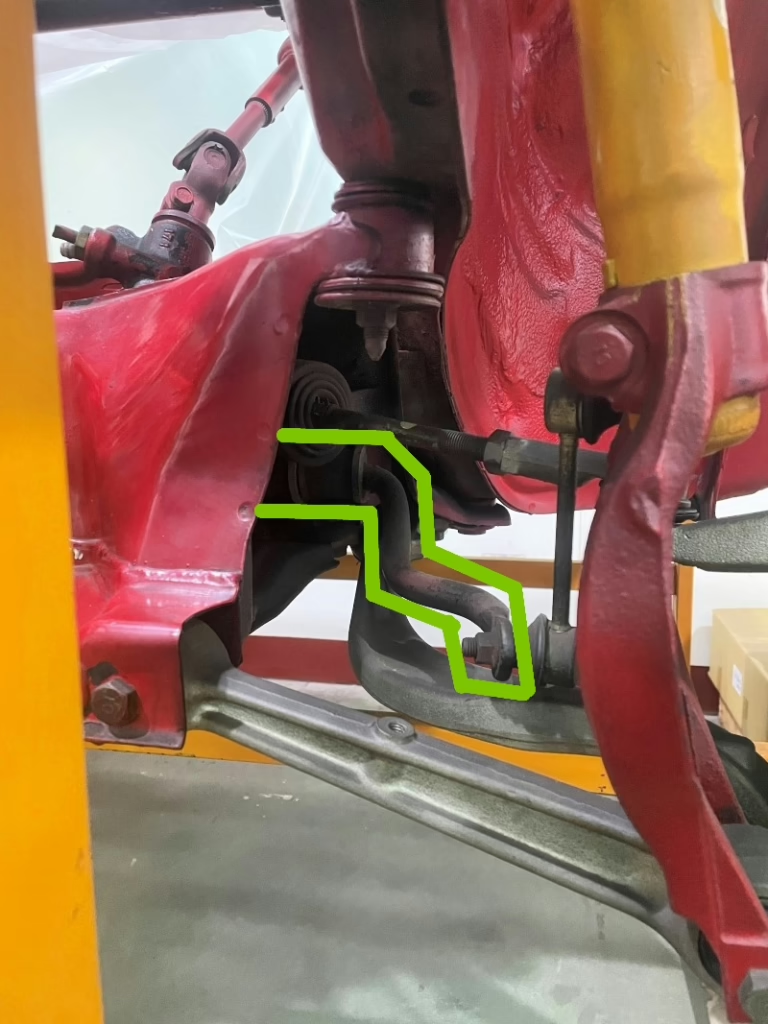
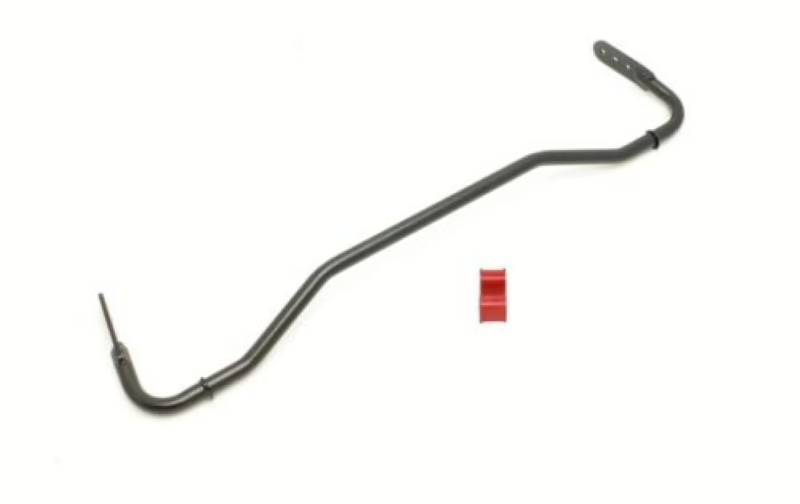
Joint and Bushing
The components mentioned above are all made of metal. To ensure that all components work together, they need to be interconnected. However, if they are simply fastened with screws, direct metal-to-metal friction can lead to noise, reduced ride comfort, and wear. Therefore, we need bushings to serve as intermediary connecting components. The bushing has a ring-shaped structure, with an outer layer encapsulating rubber, which in turn encases an inner tube. With this construction, when the components are fastened, the rubber can effectively absorb shocks, providing a more comfortable riding experience.
Ball Joint
A ball joint is a spherical structure located at one end of the control arm, connected to the steering knuckle. When the tie rod moves, it causes the steering knuckle to turn. If the endpoint of the control arm connected to the steering knuckle is locked, steering cannot be achieved (similar to joints in the human body). The quality of the ball joint is a significant factor in determining the vehicle’s handling. As mentioned earlier, the control arm controls the position of the tires, and the ball joint is crucial. It needs to withstand various forces from the tires and consistently control the tire’s movement within a specified range.
Type of suspension systems
The suspension system can be classified in various ways, and the following attempts to list different methods of classification and provide simple explanations. However, due to the multitude of design approaches and the modifications made by different manufacturers, new suspension classifications may arise as variations of existing designs, sharing similar underlying principles.
Therefore, explaining it comprehensively is not easy. The design of a suspension system is not inherently good or bad; it depends on the requirements set by the manufacturer for a particular vehicle. Factors influencing the design include cost considerations, geometric structure, the intended purpose of the vehicle (comfort, sportiness, or load-bearing capacity), collaborative development, market acceptance, and more.
The configuration of a suspension system is generally determined by three main components:
- Shock absorber
- Control Arm
- Vehicle Structure
To clearly describe the suspension structure of the vehicle, it can be categorized into the following types. Some can be combined, while others cannot, and there are also hybrid forms. The following are common configurations:
Main components
| Spring | Control Arm | Structure |
| Coil Spring | MacPherson strut | Torsion Beam |
| Leaf spring | Double Wishbone | Solid Axle |
| Torsion bar | Multi-link | Swing Axle |
| Air spring | Trailing Arm | |
| Semi-trailing Arm |
Independent/Non-independent Classification
| Independent | Non-independent | Semi-Independent |
| Double Wishbone | Solid Axle | Torsion Beam |
| Multi-Link | ||
| MacPherson Strut | ||
| Trailing Arm | ||
| Semi-trailing Arm |
Front and Rear Axle Classification
| Front | Rear |
| Double Wishbone | Solid Axle |
| MacPherson Strut | Torsion Beam |
| Multi-Link | Trailing Arm |
| Semi-trailing Arm | |
| Multi-Link | |
| Double Wishbone |
The common classifications and types of suspensions listed above will be used to explore the differences in characteristics among various suspensions based on actual car models.
- Double Wishbone
F/ Ferrari 812 superfast
F/ BMW 7-Series (G70) - Multi-Link
R/ Alfa-Romeo GIULIA (952)
F/ M-Benz S-Class (W223) - MacPherson Strut
F/ NISSAN X-TRIAL (T33)
F/ HONDA CR-V (Gen 6) - Torsion Beam (often combined with trailing arm)
R/ TOYOTA COROLLA (E210*)
R/ PEUGEOT 208 (P21) - Solid Axle
R/ FORD F-150 (Gen 14)
R/ GMX SIETTA 1500 (Gen 5)
** In 2023, the Toyota Corolla underwent a rear suspension change, transitioning from a double-wishbone setup to a torsion beam.**
By those models, we can clearly understand the features of various suspensions. However, some models have interesting suspension configurations, often different from our perceptions. Here are two models. People who are interested can try to think about why the manufacturers chose to design their cars this way.
- Porsche 911 GT2 RS (991.2)-Front/ MacPherson
In 2018, it set a record at the Nürburgring Nordschleife, becoming the fastest production car (until in 2023.) However, the new generation of 911 (992 Gen) changed its front suspension from MacPherson to double wishbone.
- TOYOTA corolla (E210)-Rear/ Torsion Beam
In 2019, the all-new facelift Corolla abandoned the previous torsion beam design for the rear axle, opting for a double-wishbone suspension. However, in the 2023 facelift, the torsion beam configuration was reintroduced (in some entry trims).
Signs of bad suspension
The suspension system is called a “system” because it’s made up of various parts working together. Therefore, explaining what happens when the suspension fails can be quite challenging, as any one of the components we introduced earlier could be the root cause. If any of the following issues come up, we strongly recommend taking your car to a professional for inspection and repair rather than attempting to fix it yourself, as identifying the broke component can be quite challenging.
1 Rattling, Clunking, and Other Noises
When you hear clunking or rattling sounds coming from the chassis, it likely means that one of the parts is damaged. Any joints, bushings, or dampers can be the source of abnormal sounds, which means that without lifting the car, it’s difficult to pinpoint exactly which part is causing the noise. Generally speaking, the most common culprits are the shock absorbers (or struts), followed by the steering system, and finally the control arms. However, for certain European cars, specific control arms are more prone to damage.
2 bouncy and unstable feeling
This relates to struts and shock absorbers. When your vehicle drives over potholes or bumps, the damper in the shock absorber is responsible for absorbing most of the vibrations and quickly bringing the car back to a stable state. However, if the shock absorber is damaged, it won’t be able to effectively absorb those vibrations. For instance, a functional shock absorber will usually allow the car to bounce twice after hitting a pothole before returning to stability. On the other hand, a worn-out shock absorber might cause the car to bounce four times before settling down. Shock absorber wear happens gradually over time and with mileage, so you won’t suddenly wake up one day to find the vehicle excessively shaking. This makes damage to the shock absorber hard to notice. Generally, European car OE shock absorbers are designed to last around 80,000 miles and Japanese car can last over 100,000 miles.
3 Increased Difficulty of Wheel Alignment
People, including less experienced mechanics, often overlook this issue and repeatedly check whether the alignment machine is malfunctioning. The components responsible for managing the wheel angles are the control arms. Therefore, when any of the control arms are damaged, achieving proper chassis alignment becomes impossible. Even if you successfully align the wheels using the alignment machine, the moment the car touches the road, the alignment angles will immediately go out of place again.
4 Uneven tire wear
This is similar to the principle of wheel alignment. When your control arms are unable to keep the tires in their designated positions, the tires will wear unevenly. This uneven wear will significantly shorten the lifespan of your tires.
Q&A
Q1 Can I Drive with Bad Suspension?
A: Suspension parts, especially control arms, are considered safety parts in the automotive industry. They are designed to be highly durable, so when your car starts to make minor noises, there’s no need to panic. Simply take it to a repair shop for replacement as soon as possible.
On the other hand, driving a car with a damaged suspension is extremely dangerous, and we strongly advise against it. The suspension system controls everything about how your vehicle handles while driving. Unlike a broken air conditioner, which you might be able to tolerate, suspension issues can lead to a loss of vehicle control. This not only endangers you but also puts other road users at risk.
That said, if your vehicle is regularly maintained and the mechanics follow the manufacturer’s mileage guidelines for chassis inspections, suspension-related catastrophic failures are relatively uncommon compared to other vehicle systems.
Q2 What causes a suspension system to fail?
A: Driving on rough and uneven roads can accelerate the wear and tear on your chassis system. Generally speaking, original equipment (OE) suspension systems are designed for paved roads and can last up to around 80,000 miles. However, if your vehicle frequently encounters potholes or bumps without proper braking, it puts additional strain on your suspension. For example, the level of impact from activities like pickup truck rallies is far beyond what an OE suspension can hold.
However, cars are built to be used in everyday driving conditions, and we don’t recommend becoming overly anxious about protecting the suspension to the point where it affects your driving comfort and confidence.
Conclusion
The above briefly introduces the basics of the suspension system, from historical development, and component explanations to the forms of suspension systems. Each component of the automotive suspension system plays a crucial role in the overall performance of the vehicle and the comfort of the driver and passengers. Regularly inspecting and maintaining the suspension system is the key to ensuring driving safety and enhancing the driving experience. Hoping that reading this article has given you a preliminary understanding of automotive suspension systems.
Reference
- TGQ R&D
- Chassis Handbook Bernd Heißing, Metin Ersoy (2010)
- 自動車のサスペンション KYB株式会社 (2013)
- 車両運動性能とシャシーメカニズム 宇野高明 (2022)
- Automotive Makers Websites
